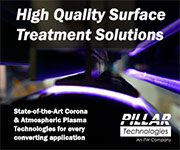Static Beat: Charge Control Antistatic Layers
- Published: February 01, 2011, By By Dr. Kelly Robinson Contributing Editor
Product formulations are driven by features and costs. The product must satisfy customer requirements, and the production costs must support an acceptable profit margin. Designing products for good static performance meets both needs. Customers need products with good static performance to avoid sheet sticking, jams, and contamination issues. High levels of static can be the root cause of production downtime and material waste.
Many product formulations include antistatic layers or coatings. Antistatic layers may be categorized in two broad categories: conductive layers and charge control layers. Each type of antistatic layer has advantages and drawbacks as summarized in Table 1. Of course, any product design that includes an additional layer, coating, or additive will have a higher cost. The design challenge is to achieve satisfactory static performance at an acceptable cost.
Static charge is a problem when there is too much. Charge control layers minimize charging between surfaces. High levels of static often occur on the unwinding rolls for slitting and for sheeting operations where the front and back sides of the film have widely different charging properties. Examples of products prone to unwinding electrification are rolls of film coated on one side; rolls of multilayer, coextruded products; and laminated films. In each case, tribocharging of the film surfaces occurs when the film is unwound as in Figure 1. As the roll unwinds, Figure 2 shows that the outside surface of the roll has a high level of charge while the film span from the unwinding roll to the first roller is nearly neutral.
The charging properties of the front and back sides of the product may be controlled by using charge control agents. If either the front or back sides are coated, the charge control agents are surfactants added to the coating solution. A charge control layer may be coated on the back side specifically to control charging against the feature coating on the front side. The back side coating often includes particles to increase the surface roughness. The increase in surface roughness improves both static performance and wound roll integrity by increasing the coefficient of friction. In addition to improving static performance, the backside layer also may be formulated to control curl.
In coextruded products, the skin layers may contain charge control additives in addition to other components. Finally, laminated film presents a unique challenge as there are no coatings or surface formulation options. Good static control in the manufacturing process may be the only option.
Product may be designed with antistatic layers to provide good static performance. Charge control layers work by minimizing tribocharging. The front and back sides of the product should be well balanced, and both sides should be nearly neutral charging in customer applications. XGeneve
Table I
| Conductive Layers | Charge Control Layers | |
|---|---|---|
| Operating principle | Dissipates static | Minimizes static charging |
| Materials | Polymeric additives, salts, conductive polymer, fibers & particles | Surfactants, charge control agents |
| Implementation | Additional layer or coating | Additive to existing layer or coating |
| Location | Surface layer or internal layer | Must be a surface layer |
| RH sensitivity | High for ionic conductors, low for electronic conductors | Minimal |
| Process sensitivity | Low | Performance is material specific |
| Cost | Higher | Lower |
Static control expert Dr. Kelly Robinson, president of Electrostatic Answers, has 27+ years of experience in problem-solving and consulting. Contact him at 585-425-8158; kelly.robinson@electrostaticanswers.com; www.electrostaticanswers.com.













